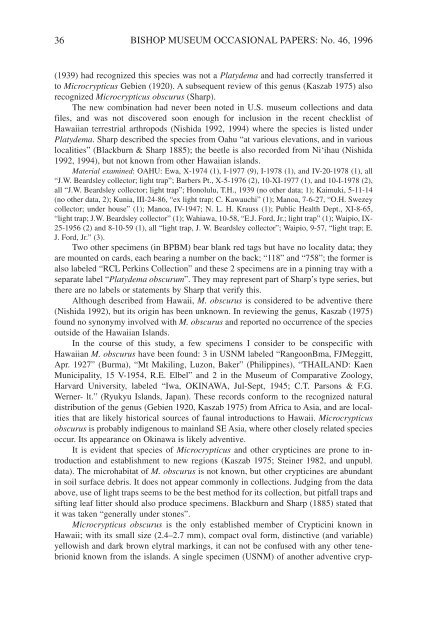Notes - Hawaii Biological Survey - Bishop Museum
Notes - Hawaii Biological Survey - Bishop Museum
Notes - Hawaii Biological Survey - Bishop Museum
You also want an ePaper? Increase the reach of your titles
YUMPU automatically turns print PDFs into web optimized ePapers that Google loves.
36<br />
BISHOP MUSEUM OCCASIONAL PAPERS: No. 46, 1996<br />
(1939) had recognized this species was not a Platydema and had correctly transferred it<br />
to Microcrypticus Gebien (1920). A subsequent review of this genus (Kaszab 1975) also<br />
recognized Microcrypticus obscurus (Sharp).<br />
The new combination had never been noted in U.S. museum collections and data<br />
files, and was not discovered soon enough for inclusion in the recent checklist of<br />
<strong>Hawaii</strong>an terrestrial arthropods (Nishida 1992, 1994) where the species is listed under<br />
Platydema. Sharp described the species from Oahu “at various elevations, and in various<br />
localities” (Blackburn & Sharp 1885); the beetle is also recorded from Ni‘ihau (Nishida<br />
1992, 1994), but not known from other <strong>Hawaii</strong>an islands.<br />
Material examined: OAHU: Ewa, X-1974 (1), I-1977 (9), I-1978 (1), and IV-20-1978 (1), all<br />
“J.W. Beardsley collector; light trap”; Barbers Pt., X-5-1976 (2), 10-XI-1977 (1), and 10-I-1978 (2),<br />
all “J.W. Beardsley collector; light trap”; Honolulu, T.H., 1939 (no other data; 1); Kaimuki, 5-11-14<br />
(no other data, 2); Kunia, III-24-86, “ex light trap; C. Kawauchi” (1); Manoa, 7-6-27, “O.H. Swezey<br />
collector; under house” (1); Manoa, IV-1947; N. L. H. Krauss (1); Public Health Dept., XI-8-65,<br />
“light trap; J.W. Beardsley collector” (1); Wahiawa, 10-58, “E.J. Ford, Jr.; light trap” (1); Waipio, IX-<br />
25-1956 (2) and 8-10-59 (1), all “light trap, J. W. Beardsley collector”; Waipio, 9-57, “light trap; E.<br />
J. Ford, Jr.” (3).<br />
Two other specimens (in BPBM) bear blank red tags but have no locality data; they<br />
are mounted on cards, each bearing a number on the back; “118” and “758”; the former is<br />
also labeled “RCL Perkins Collection” and these 2 specimens are in a pinning tray with a<br />
separate label “Platydema obscurum”. They may represent part of Sharp’s type series, but<br />
there are no labels or statements by Sharp that verify this.<br />
Although described from <strong>Hawaii</strong>, M. obscurus is considered to be adventive there<br />
(Nishida 1992), but its origin has been unknown. In reviewing the genus, Kaszab (1975)<br />
found no synonymy involved with M. obscurus and reported no occurrence of the species<br />
outside of the <strong>Hawaii</strong>an Islands.<br />
In the course of this study, a few specimens I consider to be conspecific with<br />
<strong>Hawaii</strong>an M. obscurus have been found: 3 in USNM labeled “RangoonBma, FJMeggitt,<br />
Apr. 1927” (Burma), “Mt Makiling, Luzon, Baker” (Philippines), “THAILAND: Kaen<br />
Municipality, 15 V-1954, R.E. Elbel” and 2 in the <strong>Museum</strong> of Comparative Zoology,<br />
Harvard University, labeled “Iwa, OKINAWA, Jul-Sept, 1945; C.T. Parsons & F.G.<br />
Werner- lt.” (Ryukyu Islands, Japan). These records conform to the recognized natural<br />
distribution of the genus (Gebien 1920, Kaszab 1975) from Africa to Asia, and are localities<br />
that are likely historical sources of faunal introductions to <strong>Hawaii</strong>. Microcrypticus<br />
obscurus is probably indigenous to mainland SE Asia, where other closely related species<br />
occur. Its appearance on Okinawa is likely adventive.<br />
It is evident that species of Microcrypticus and other crypticines are prone to introduction<br />
and establishment to new regions (Kaszab 1975; Steiner 1982, and unpubl.<br />
data). The microhabitat of M. obscurus is not known, but other crypticines are abundant<br />
in soil surface debris. It does not appear commonly in collections. Judging from the data<br />
above, use of light traps seems to be the best method for its collection, but pitfall traps and<br />
sifting leaf litter should also produce specimens. Blackburn and Sharp (1885) stated that<br />
it was taken “generally under stones”.<br />
Microcrypticus obscurus is the only established member of Crypticini known in<br />
<strong>Hawaii</strong>; with its small size (2.4–2.7 mm), compact oval form, distinctive (and variable)<br />
yellowish and dark brown elytral markings, it can not be confused with any other tenebrionid<br />
known from the islands. A single specimen (USNM) of another adventive cryp-
















